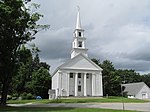Elliott Laurel
1941 establishments in MassachusettsOpen space reserves of MassachusettsProtected areas established in 1941Protected areas of Worcester County, MassachusettsThe Trustees of Reservations ... and 1 more
Worcester County, Massachusetts geography stubs

Elliott Laurel is a 33-acre (13 ha) open space preserve located in Phillipston, Massachusetts. The property, notable for its extensive stands of mountain laurel, is managed by the land conservation non-profit organization The Trustees of Reservations. Elliott Laurel also contains woodlands, ledges, boulders, and a hayfield.
Excerpt from the Wikipedia article Elliott Laurel (License: CC BY-SA 3.0, Authors, Images).Elliott Laurel
Searles Hill Road,
Geographical coordinates (GPS) Address Website Nearby Places Show on map
Geographical coordinates (GPS)
| Latitude | Longitude |
|---|---|
| N 42.529 ° | E -72.123 ° |
Address
Elliott Laurel
Searles Hill Road
Massachusetts, United States
Open on Google Maps










